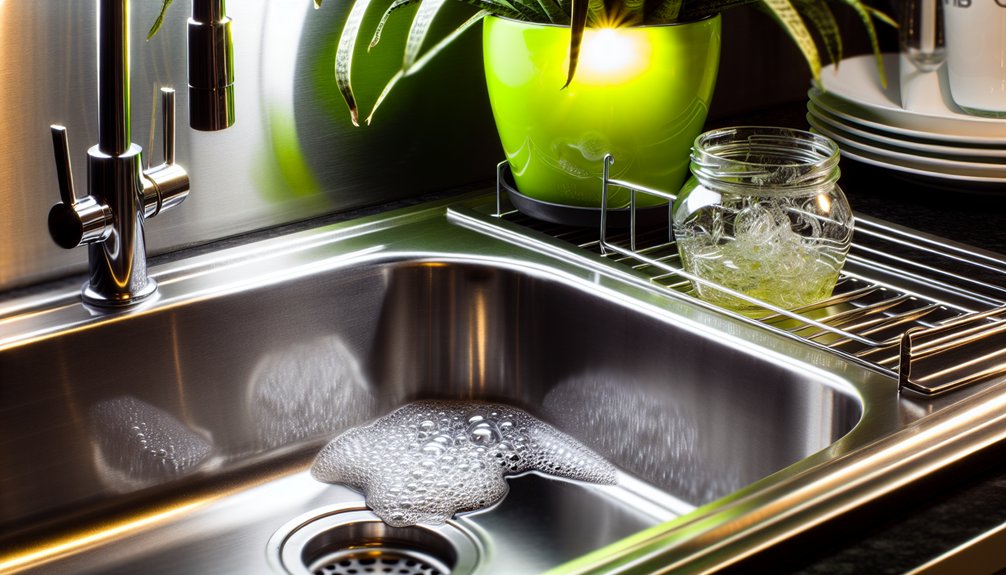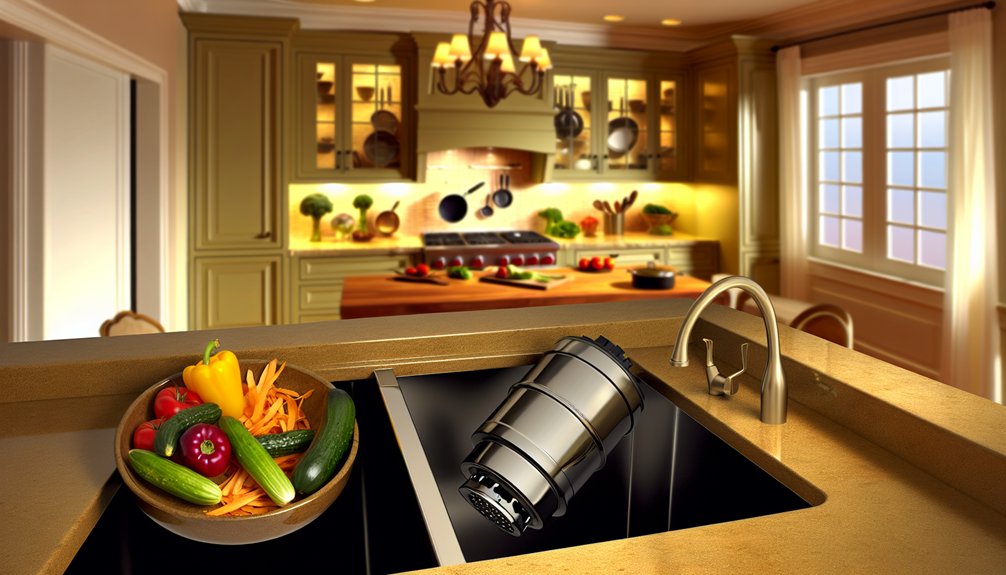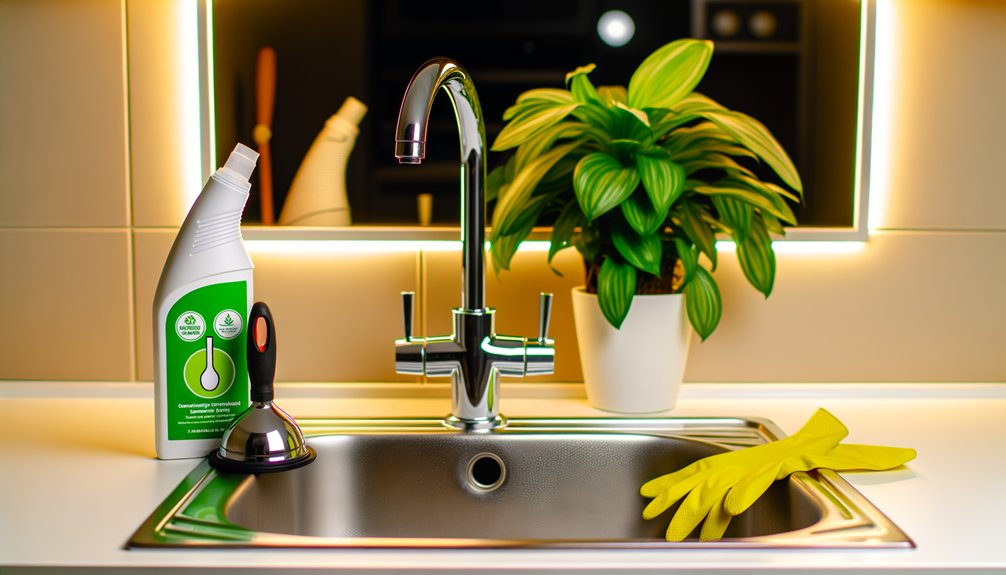Effective household drain maintenance involves several key practices. Clean drains monthly to prevent clogs. Always flush only human waste and toilet paper. Avoid pouring grease down kitchen sinks to prevent significant plumbing issues. Use garbage disposals sparingly and refrain from overloading them. Manage root growth away from sewer lines. Maintain water pressure below 80 psi. Schedule professional sewer line inspections every three years. Protect pipes from freezing and consider replacing old plumbing materials to guarantee system integrity. More strategies await attention.
Clean Every Drain Every Month

A consistent monthly drain cleaning routine is essential for homeowners seeking to prevent clogs and costly plumbing repairs. By committing to clean your drains regularly, homeowners can effectively eliminate the buildup of gunk and debris that often leads to clogged drains. Utilizing enzyme-based cleaners is advisable, as these formulations break down organic materials without harming plumbing systems. For a more natural approach, a mixture of baking soda and vinegar can be employed; allowing this solution to sit for 15 minutes before rinsing with boiling water enhances its efficacy against minor blockages. Maintaining this maintenance routine not only optimizes flow but also mitigates unpleasant odors associated with stagnant waste. Establishing a disciplined approach to drain cleaning can notably save time and financial resources, empowering homeowners to prevent future plumbing crises and maintain a sanitary living environment.
Flush Correctly
Flushing correctly is essential for maintaining a functional plumbing system and preventing costly blockages. To guarantee peak drainage performance, only human waste and toilet paper should be flushed down the toilet. Flushing inappropriate items can lead to a clogged drain and significant plumbing issues.
To help household members understand proper flushing habits, consider the following guidelines:
- Only flush human waste and toilet paper.
- Avoid flushing diapers, wipes, feminine products, and kitty litter.
- Educate everyone about the risks of improper flushing.
Never Pour Grease Down Your Kitchen Drain

Pouring grease down the kitchen drain poses significant risks, as it leads to the formation of build-ups that can severely restrict water flow and contribute to costly plumbing issues. Proper disposal methods, such as using paper towels or designated containers, are essential for maintaining an efficient drainage system. Additionally, adopting alternative cooking practices can further minimize grease waste and enhance household plumbing health.
Grease Buildup Consequences
Grease buildup in kitchen drains poses significant risks to plumbing systems, often leading to severe operational issues. When grease is poured down the drain, it can coat pipes, resulting in slower drainage and ultimately severe clogs. These clogs necessitate professional intervention and can lead to further complications such as:
- Formation of fatbergs in sewer systems, reaching sizes of up to 11 feet wide
- Unpleasant odors emanating from accumulated grease
- Attraction of pests into the home due to stagnant waste
Proper Disposal Methods
The accumulation of grease in kitchen drains can be effectively mitigated through proper disposal methods. Pouring grease down the drain contributes greatly to plumbing issues, including severe clogs and fatbergs that can reach sizes of 11 feet wide. To prevent such problems, individuals should use paper towels to absorb excess grease and dispose of them in the trash. Additionally, collecting used cooking oils in a sealed container for recycling or disposal at designated centers is recommended. Regular maintenance of kitchen drains, coupled with proper disposal methods, can prolong the lifespan of plumbing systems and minimize the risk of backups.
| Grease Disposal Methods | Benefits | Consequences of Ignoring |
|---|---|---|
| Paper Towels | Prevents clogs | Increased plumbing repairs |
| Sealed Containers | Environmentally friendly disposal | Fatberg formation |
| Recycling Centers | Sustainable waste management | Costly drainage issues |
| Regular Cleaning | Extends plumbing system life | Frequent backups |
Alternative Cooking Practices
When considering alternative cooking practices, it is essential to recognize the importance of proper grease disposal in maintaining plumbing health. Pouring grease down the kitchen drain can lead to severe plumbing issues, including the formation of fatbergs that can cause significant clogs. To avoid these problems, the following methods are recommended:
- Use paper towels to absorb excess grease before disposal.
- Dispose of the soaked paper towels in the trash, ensuring no grease enters the plumbing.
- Treat the kitchen sink exclusively for human waste and toilet paper, avoiding cooking oils or fats.
Use Your Garbage Disposal Sparingly

Using a garbage disposal carelessly can lead to significant plumbing issues, including clogs and costly repairs. To guarantee effective maintenance, it is essential to use the disposal sparingly, treating it as a device for minor food scraps rather than a general waste disposal unit. Overloading the system with fibrous foods such as celery, asparagus, pasta, rice, and coffee grounds can create blockages that hinder its efficiency.
To promote peak performance, homeowners should regularly run cold water before, during, and after usage. This practice helps wash food particles down the drain and prevents buildup. Additionally, grinding ice cubes occasionally can clean and sharpen the disposal blades, enhancing functionality. By adhering to these guidelines, individuals can prolong the life of their garbage disposal and maintain a free-flowing plumbing system, ultimately avoiding the pitfalls of clogs and extensive repairs.
Keep Roots Away From Your Sewer Line
To prevent serious plumbing issues, homeowners must be vigilant about keeping roots away from sewer lines, as tree and bush roots can infiltrate these systems, leading to costly clogs and damage. Monitoring landscaping near sewer lines is essential, since roots are naturally drawn to the moisture and nutrients found within.
Homeowners should consider the following strategies to mitigate root intrusion:
- Conduct regular inspections every three years to identify any potential root issues.
- Implement root barriers during landscaping to deter roots from growing towards sewer lines.
- Engage professionals for services like hydro jetting if root intrusion is suspected, ensuring a thorough clearance.
Use a Drain Guard
A drain guard serves as an effective barrier against debris, such as hair and food particles, that can lead to plumbing clogs. Available in various sizes and materials, these tools can be easily installed in sinks, bathtubs, and showers. Regular maintenance of drain guards, including cleaning and emptying, is essential to maximize their performance and minimize plumbing issues.
Benefits of Drain Guards
Although often overlooked, the implementation of drain guards provides substantial benefits in household drain maintenance. These devices effectively catch debris such as hair, food particles, and soap scum, preventing clogs from forming in plumbing systems. Their advantages include:
- Cost-effectiveness: They greatly reduce the frequency of drain cleaning and maintenance efforts.
- Ease of use: Drain guards are easy to install and available in various sizes and materials for different drains.
- Odor control: Regular cleaning of drain guards helps maintain ideal water flow and reduces unpleasant odors associated with stagnant debris.
Types of Drain Guards
Drain guards, vital tools for maintaining household plumbing, come in various designs tailored to meet specific needs. These devices, known for their efficiency, include mesh screens, silicone catchers, and stainless steel options. Each type offers unique benefits; for instance, mesh screens are lightweight and easy to clean, while silicone catchers provide flexibility and durability. By effectively capturing debris such as hair, food particles, and soap scum, drain guards prevent clogs, thereby ensuring ideal water flow in sinks, bathtubs, and showers. Regular maintenance of these guards is important, as it helps to extend the lifespan of the plumbing system and minimizes the risk of costly repairs. Overall, utilizing the appropriate drain guard is a simple yet effective strategy for household drain maintenance.
Installation and Maintenance Tips
Proper installation and maintenance of a drain guard greatly enhances its effectiveness in preventing clogs and maintaining ideal plumbing function. Installing a drain guard in sinks and bathtubs is an effective strategy for promoting an efficient plumbing system.
To maximize its performance, consider the following tips:
- Choose the appropriate type of drain guard, such as mesh screens or hair catchers, for your specific drains.
- Regularly emptying and cleaning the drain guard prevents debris build-up and unpleasant odors.
- Inspect the drain guard periodically to verify it remains securely in place and functions correctly.
Set Your Water Pressure No Higher Than 80 Psi
Maintaining water pressure at a suitable level is essential for the longevity and functionality of a home's plumbing system. Setting water pressure no higher than 80 psi greatly reduces the risk of leaks and pipe damage over time. Excessive pressure can lead to cracks in joints and pipes, resulting in costly repairs.
To monitor and manage water pressure effectively, homeowners can utilize a water pressure gauge. If levels exceed the recommended threshold, installing a pressure regulator can help maintain ideal performance. Regularly checking water pressure not only safeguards the plumbing system but also enhances overall efficiency.
| Pressure Level (psi) | Risk of Damage | Recommended Action |
|---|---|---|
| Below 40 | Low pressure; weak flow | No action needed |
| 40 – 80 | Normal operation | Regular monitoring |
| 80 – 100 | Increased leaks | Install pressure regulator |
| 100 – 120 | High risk of damage | Immediate action needed |
| Above 120 | Severe damage risk | Consult a professional |
Have Your Sewer Line Professionally Inspected Every Three Years
Regular professional inspections of sewer lines every three years are essential for identifying potential issues that could lead to costly repairs and backups. These inspections utilize advanced techniques, such as snaking and hydrojetting, to clear blockages and maintain peak flow. Homes situated near large trees or dense foliage may particularly benefit from this proactive approach to prevent root intrusions and extend the plumbing system's lifespan.
Importance of Regular Inspections
Although many homeowners may overlook the importance of sewer line maintenance, having the system professionally inspected every three years is essential for preventing major plumbing issues. Regular inspections provide several benefits:
- Identify potential issues: Early detection of problems can avert costly repairs.
- Prevent root intrusion: Inspections are critical for homes near trees, as roots can damage pipes.
- Ensure pipe maintenance: Techniques like snaking or hydrojetting maintain the health of the sewer line.
Scheduling these inspections not only offers peace of mind concerning the sewer system's condition but also extends its longevity. Neglecting regular inspections can result in severe plumbing emergencies, which may prove to be considerably more expensive than routine maintenance. As a result, proactive measures are important for safeguarding one's home.
Preventing Costly Repairs
Having a sewer line professionally inspected every three years greatly reduces the risk of costly repairs. These inspections can identify potential issues, such as tree root invasions, that may lead to significant damage if not addressed promptly. By utilizing specialized tools, professionals can clear build-up and extend the lifespan of the sewer system, guaranteeing it operates effectively. Regularly maintaining drains through these inspections provides homeowners with peace of mind, minimizing the risk of plumbing emergencies.
| Benefit | Description |
|---|---|
| Early Issue Detection | Identifies problems before they escalate. |
| Cost Savings | Prevents expensive repairs by addressing issues early. |
| Enhanced Efficiency | Keeps sewer systems functioning efficiently. |
| Peace of Mind | Guarantees reliability in home maintenance. |
| Longevity of System | Extends the life of your sewer line. |
Professional Techniques and Tools
Maintaining the integrity of a home's sewer system depends considerably on the methods and tools employed during inspections. Professionals recommend having the sewer line inspected every three years, utilizing specialized tools to guarantee thorough evaluations. This proactive approach can identify issues early, preventing costly repairs and unexpected backups.
Key professional techniques include:
- Camera Inspections: High-resolution cameras provide real-time visuals of the sewer line's condition.
- Hydro Jetting: This method uses high-pressure water to clear blockages and clean pipes effectively.
- Root Infiltration Analysis: Detects potential damage from nearby tree roots, which can severely impact the sewer system.
Prevent Water From Freezing in Your Pipes
As temperatures drop during winter months, the risk of water freezing in pipes increases considerably, potentially leading to costly damage. To effectively prevent water from freezing in your pipes, homeowners should take several precautionary measures. First, insulating pipes located in unheated areas such as attics, basements, and crawl spaces is vital. This insulation helps maintain a stable temperature, minimizing the risk of freezing. Additionally, allowing faucets to drip during extreme cold weather can relieve pressure within the plumbing system, further reducing the chance of ice formation. It is also essential to monitor temperature fluctuations closely, as sudden drops may necessitate further action. Finally, opening cabinet doors under sinks enables warmer air to circulate around plumbing, offering additional protection against freezing. By implementing these strategies, homeowners can safeguard their plumbing systems during the harsh winter months.
Replace Old Pipes
When old pipes begin to deteriorate, they can pose serious risks to both water quality and the overall plumbing system. Homeowners should be vigilant about the condition of their pipes, particularly those made from materials such as galvanized steel or lead, which can greatly compromise water quality. Ignoring these issues may lead to severe plumbing problems and health risks.
Consider these key points regarding pipe replacement:
- Lifespan: Brass pipes last 40-70 years, cast iron 75-100 years, and copper around 50 years.
- Material Vulnerabilities: Galvanized steel pipes, lasting only 20-50 years, are particularly susceptible to rust and corrosion.
- Proactive Maintenance: Replacing old pipes before failure can avert costly repairs and service disruptions.
Frequently Asked Questions
How Do You Maintain Drain Pipes in a House?
To maintain drain pipes effectively, one should implement various drain cleaning techniques, such as using a baking soda and vinegar mixture monthly. Awareness of common drain problems, like clogs from improper flushing, is vital. Utilizing drain maintenance tools, including plungers and augers, can aid in resolving minor issues. Additionally, preventative drain measures, such as regular sewer line inspections and monitoring water pressure, help avert severe problems, ensuring long-term functionality of the plumbing system.
How Often Should I Clean My Drains With Baking Soda and Vinegar?
The recommended drain cleaning frequency involves using natural cleaning solutions like baking soda and vinegar monthly. This method capitalizes on vinegar baking benefits, effectively breaking down organic materials that accumulate in drains. For ideal results, a thorough treatment every three months is advisable, ensuring safe drain maintenance without harsh chemicals. Regular application of this eco-friendly technique promotes a healthier plumbing system, preventing stubborn clogs and maintaining efficient flow throughout the household.
What Is the Best Thing to Keep Drains Clear?
What if the secret to hassle-free plumbing lies in simple, eco-friendly solutions? To keep drains clear, consistent drain cleaning is vital. Employing a monthly blend of baking soda and vinegar serves as a natural remedy for clog prevention, effectively breaking down stubborn organic matter. Additionally, using drain screens can greatly reduce debris accumulation. These plumbing tips not only guarantee ideal flow but also promote a sustainable approach to household maintenance, liberating homeowners from future headaches.
Why Do Plumbers Say to Not Use Drano?
Plumbers often advise against using Drano due to the chemical dangers it poses to plumbing systems. The harsh ingredients can damage pipes, especially older ones, and may lead to expensive repairs. Additionally, Drano has limitations, failing to clear certain clogs while prompting increased usage. These factors contribute to plumbing myths surrounding drain cleaning. Safer Drano alternatives, such as enzyme-based solutions or natural methods, are recommended, effectively maintaining drains without the associated risks.



